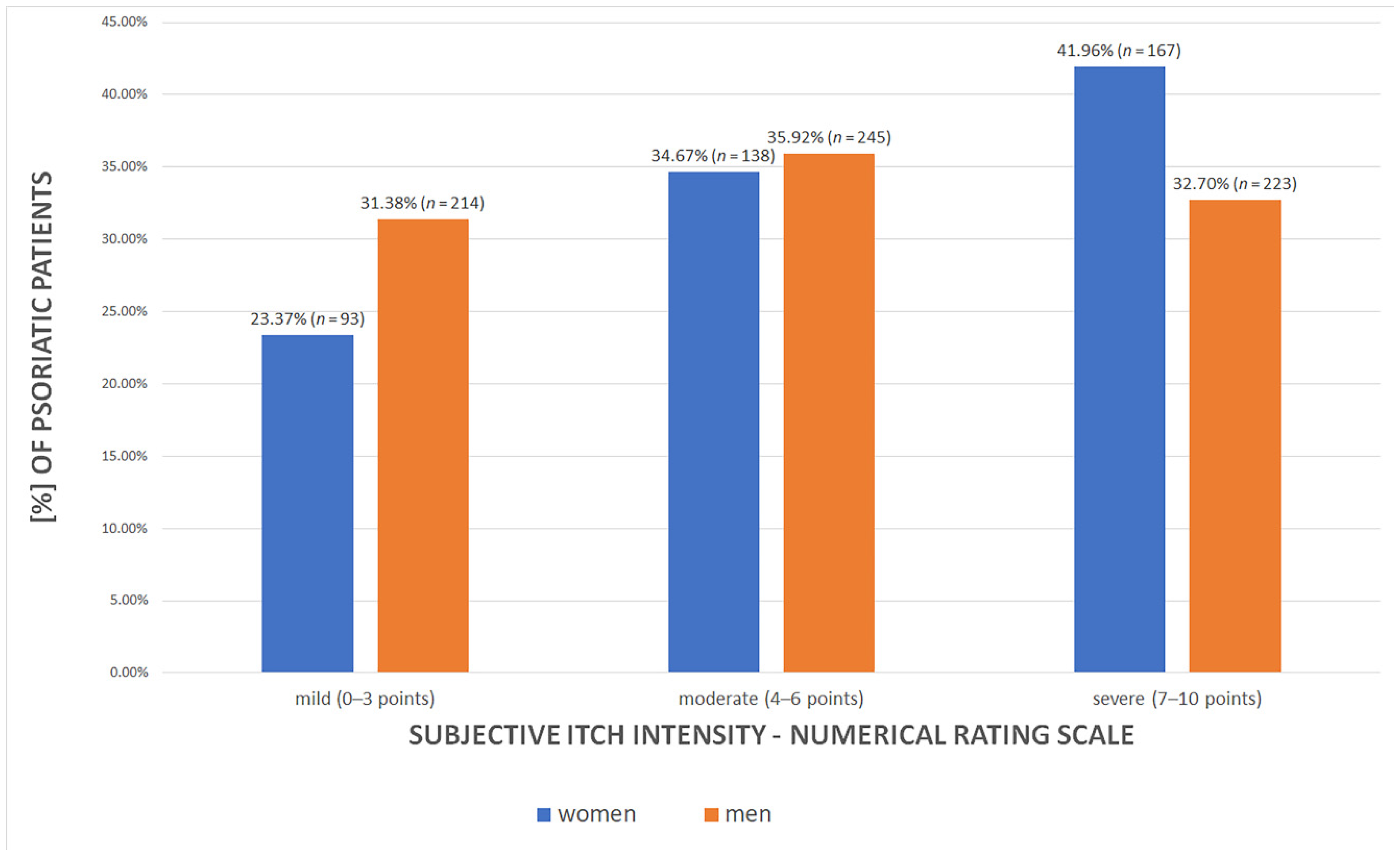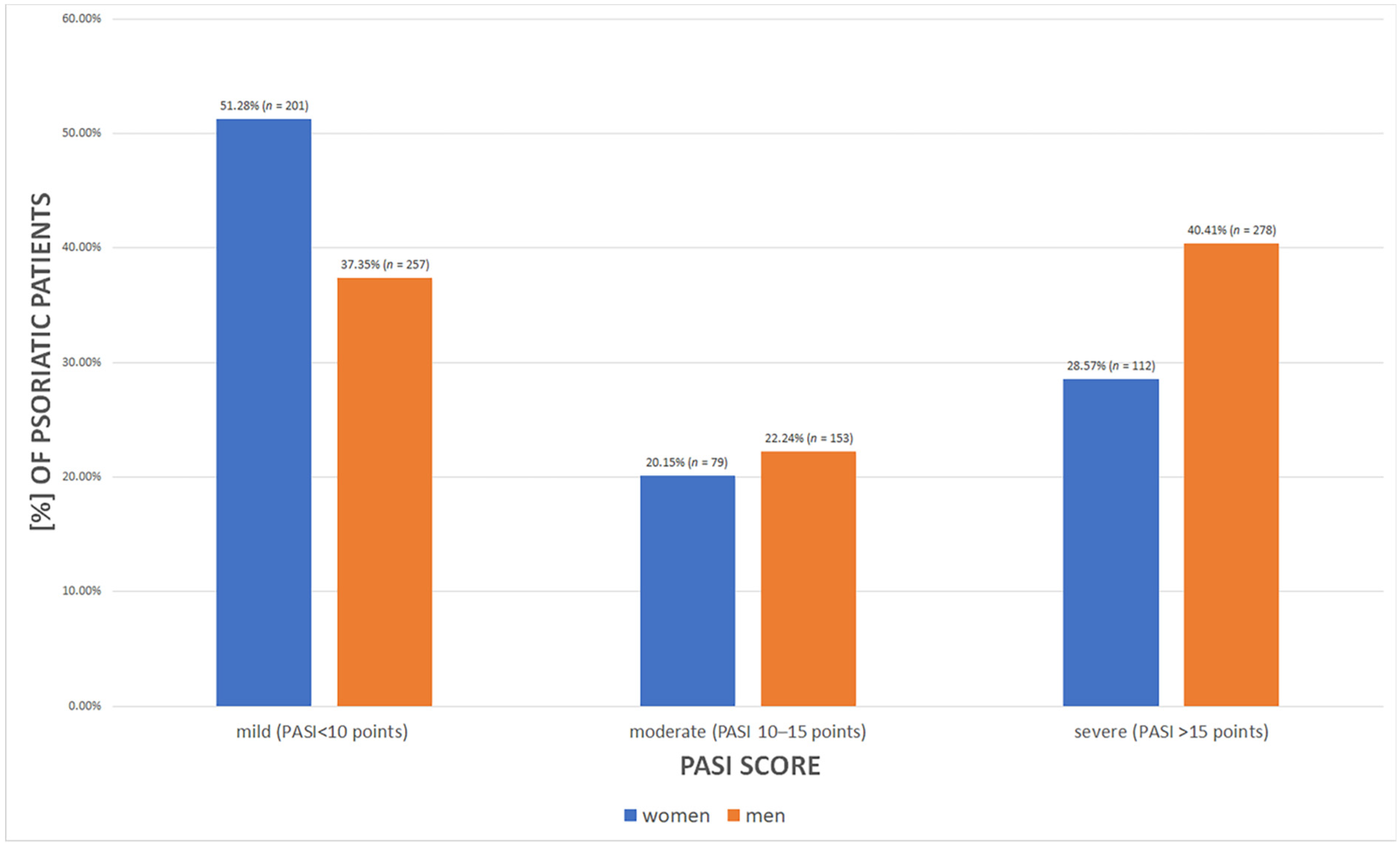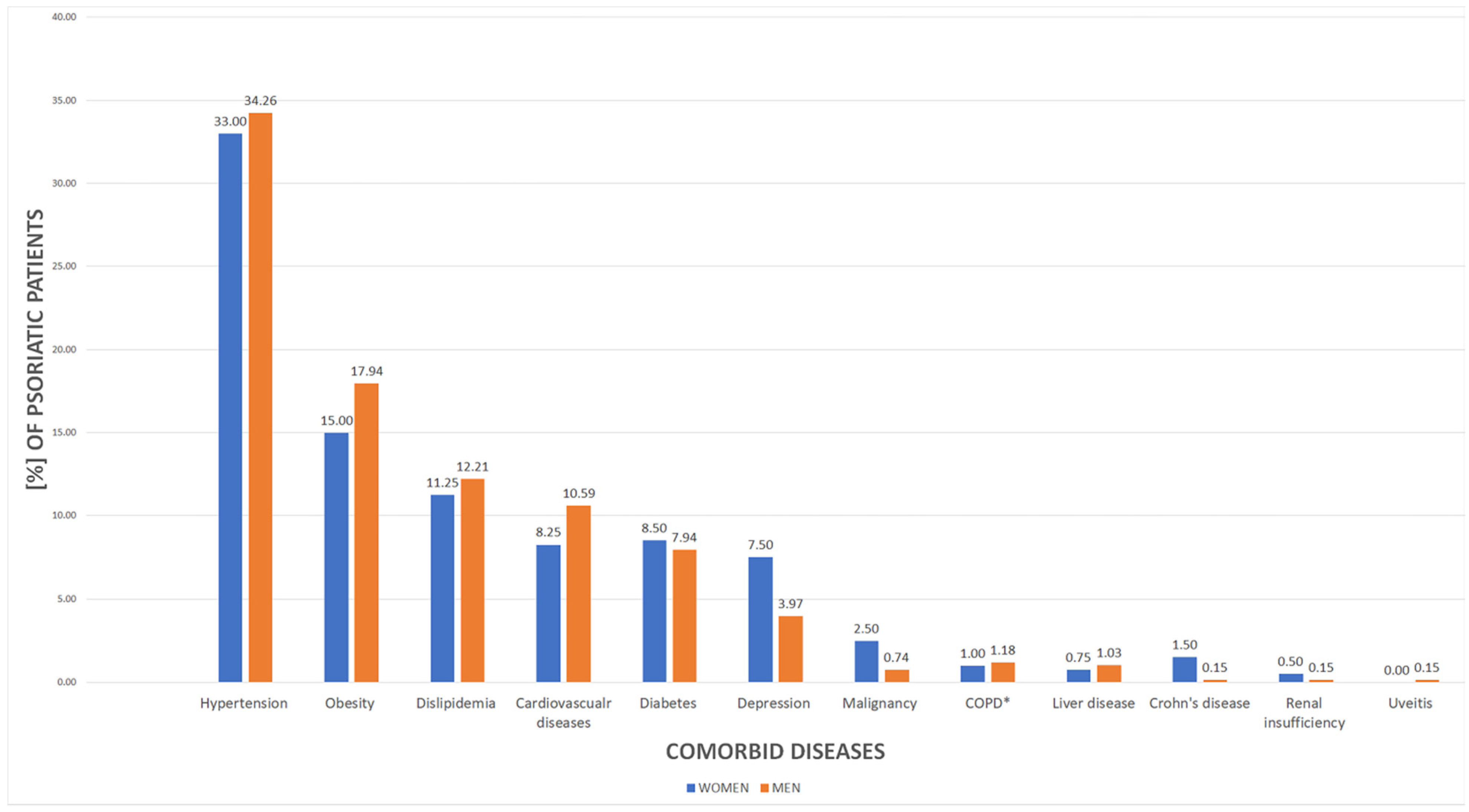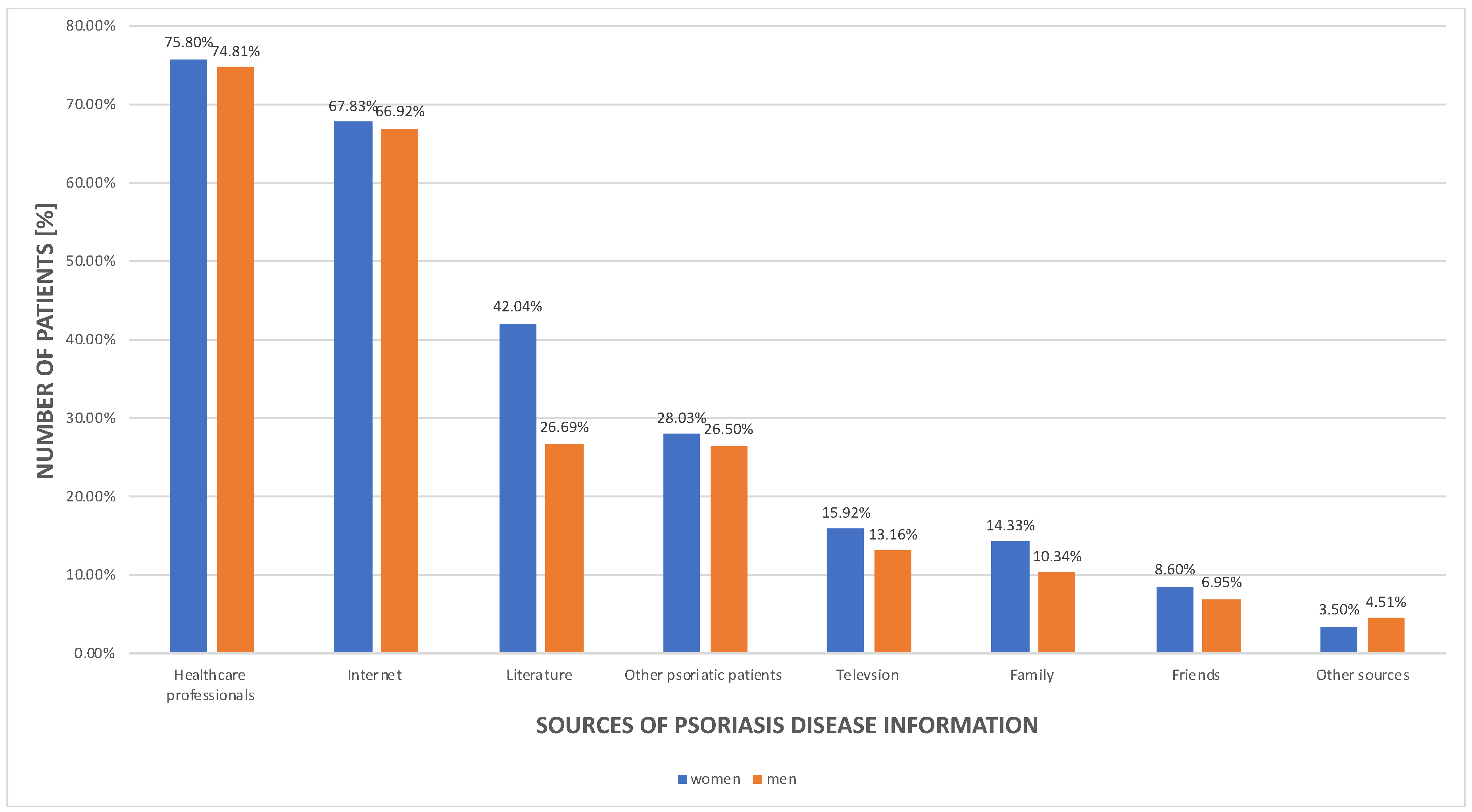Chronic Plaque Psoriasis in Poland: Disease Severity, Prevalence of Comorbidities, and Quality of Life
Abstract
1. Introduction
2. Materials and Methods
2.1. Chronic Plaque Psoriasis Patients’ Study Group
2.2. Control Population
2.3. Statistical Analysis
3. Results
3.1. Chronic Plaque Psoriatic Patients’ Disease Course, Severity, and Management Evaluation
3.2. Psoriasis and Comorbid Diseases
3.3. Psoriasis and the Environmental Factors
3.4. Knowledge about Psoriasis
4. Discussion
4.1. Disease Course, Activity, and Management Evaluation
4.2. Comorbidities
4.3. Social and Lifestyle Burden
4.4. Limitations of the Study
5. Conclusions
Author Contributions
Funding
Institutional Review Board Statement
Informed Consent Statement
Data Availability Statement
Conflicts of Interest
References
- Michalek, I.; Loring, B.; John, S. A systematic review of worldwide epidemiology of psoriasis. J. Eur. Acad. Dermatol. Venereol. 2017, 31, 205–212. [Google Scholar] [CrossRef] [PubMed]
- Borzęcki, A.; Dudra-Jastrzębska, M.; Sajdak-Wojtaluk, A. Epidemiologia łuszczycy w rejonie województwa lubelskiego w latach 2005–2009. Dermatol. Klin. 2012, 14, 149–153. [Google Scholar]
- Borzęcki, A.; Koncewicz, A.; Raszewska-Famielec, M.; Dudra-Jastrzębska, M. Epidemiology of psoriasis in the years 2008–2015. Przegl. Dermatol. 2018, 105, 693–700. [Google Scholar]
- Samotij, D.; Nedoszytko, B.; Bartosińska, J.; Batycka-Baran, A.; Czajkowski, R.; Dobrucki, I.T.; Dobrucki, L.W.; Górecka-Sokołowska, M.; Janaszak-Jasienicka, A.; Krasowska, D.; et al. Pathogenesis of psoriasis in the “omic” era. Part I. Epidemiology, clinical manifestation, immunological and neuroendocrine disturbances. Postepy Dermatol. Alergol. 2020, 37, 135–153. [Google Scholar] [CrossRef]
- Amoruso, G.F.; Nisticò, S.P.; Iannone, L.; Russo, E.; Rago, G.; Patruno, C.; Bennardo, L. Ixekizumab May Improve Renal Function in Psoriasis. Healthcare 2021, 9, 543. [Google Scholar] [CrossRef]
- Wójcik-Maciejewicz, A.; Sawińska, E.; Reich, A. Risk of cardiovascular diseases in psoriasis—The current state of knowledge. Dermatol. Rev. 2019, 106, 495–506. [Google Scholar] [CrossRef]
- Owczarczyk-Saczonek, A.; Purzycka-Bohdan, D.; Nedoszytko, B.; Reich, A.; Szczerkowska-Dobosz, A.; Bartosinska, J.; Batycka-Baran, A.; Czajkowski, R.; Dobrucki, I.T.; Dobrucki, L.W.; et al. Pathogenesis of psoriasis in the “omic” era. Part III. Metabolic disorders, metabolomics, nutrigenomics in psoriasis. Postepy Dermatol. Alergol. 2020, 37, 452–467. [Google Scholar] [CrossRef]
- Kimball, A.B.; Jacobson, C.; Weiss, S.; Vreeland, M.G.; Wu, Y. The psychosocial burden of psoriasis. Am. J. Clin. Dermatol. 2005, 6, 383–392. [Google Scholar] [CrossRef]
- Zeng, J.; Luo, S.; Huang, Y.; Lu, Q. Critical role of environmental factors in the pathogenesis of psoriasis. J. Dermatol. 2017, 44, 863–872. [Google Scholar] [CrossRef]
- Reich, A.; Riepe, C.; Anastasiadou, Z.; Mędrek, K.; Augustin, M.; Szepietowski, J.C.; Ständer, S. Itch assessment with visual analogue scale and numerical rating scale: Determination of minimal clinically important difference in chronic itch. Acta. Derm. Venereol. 2016, 96, 978–980. [Google Scholar] [CrossRef]
- Mrowietz, U.; Kragballe, K.; Reich, K.; Spuls, P.; Griffiths, C.E.; Nast, A.; Franke, J.; Antoniou, C.; Arenberger, P.; Balieva, F.; et al. Definition of treatment goals for moderate to severe psoriasis: A European consensus. Arch. Dermatol. Res. 2011, 303, 1–10. [Google Scholar] [CrossRef] [PubMed]
- Finlay, A.Y.; Khan, G.K. Dermatology Life Quality Index (DLQI)—A simple practical measure for routine clinical use. Clin. Exp. Dermatol. 1994, 19, 210–216. [Google Scholar] [CrossRef] [PubMed]
- Dobrowolska, S.; Michalska-Madej, J.; Słomka, M.; Sobalska, M.; Strapagiel, D. Biobank Łódź-population based biobank at the University of Łódź, Poland. Eur. J. Trans. Clin. Med. 2019, 2, 85–89. [Google Scholar] [CrossRef]
- Chen, L.; Tsai, T.F. HLA-Cw6 and psoriasis. Br. J. Dermatol. 2018, 178, 854–862. [Google Scholar] [CrossRef] [PubMed]
- Queiro, R.; Torre, J.C.; González, S.; López-Larrea, C.; Tinturé, T.; López-Lagunas, I. HLA antigens may influence the age of onset of psoriasis and psoriatic arthritis. J. Rheumatol. 2003, 30, 505–507. [Google Scholar]
- Szczerkowska Dobosz, A.; Rebała, K.; Szczerkowska, Z.; Nedoszytko, B. HLA-C locus alleles distribution in patients from northern Poland with psoriatic arthritis-preliminary report. Int. J. Immunogenet. 2005, 32, 389–391. [Google Scholar] [CrossRef]
- Augustin, M.; Sommer, R.; Kirsten, N.; Danckworth, A.; Radtke, M.A.; Reich, K.; Thaci, D.; Boehncke, W.H.; Langenbruch, A.; Mrowietz, U. Topology of psoriasis in routine care: Results from high-resolution analysis of 2009 patients. Br. J. Dermatol. 2019, 181, 358–365. [Google Scholar] [CrossRef]
- Egeberg, A.; See, K.; Garrelts, A.; Burge, R. Epidemiology of psoriasis in hard-to-treat body locations: Data from the Danish skin cohort. BMC Dermatol. 2020, 20, 3. [Google Scholar] [CrossRef]
- Callis Duffin, K.; Mason, M.A.; Gordon, K.; Harrison, R.W.; Crabtree, M.M.; Guana, A.; Germino, R.; Lebwohl, M. Characterization of Patients with Psoriasis in Challenging-to-Treat Body Areas in the Corrona Psoriasis Registry. Dermatology 2021, 237, 46–55. [Google Scholar] [CrossRef]
- Reich, A.; Szepietowski, J.C. Health-related quality of life in patients with nail disorders. Am. J. Clin. Dermatol. 2011, 12, 313–320. [Google Scholar] [CrossRef]
- Bardazzi, F.; Starace, M.; Bruni, F.; Magnano, M.; Piraccini, B.M.; Alessandrini, A. Nail Psoriasis: An Updated Review and Expert Opinion on Available Treatments, Including Biologics. Acta Derm. Venereol. 2019, 99, 516–523. [Google Scholar] [CrossRef] [PubMed]
- Tłustochowicz, M.; Wierzba, W.; Marczak, M.; Tłustochowicz, W.; Śliwczyński, A.; Raciborski, F.; Kwiatkowska, B.; Brzozowska, M.; Jacyna, A.; Kisiel, B. Trends in psoriatic arthritis epidemiology in Poland. Rheumatol. Int. 2021, 41, 139–145. [Google Scholar] [CrossRef]
- Moya Alvarado, P.; Roé Crespo, E.; Muñoz-Garza, F.Z.; López-Ferrer, A.; Laiz Alonso, A.; Vilarrassa Rull, E.; Pou, J.C.I.; Puig Sanz, L. Subclinical enthesopathy of extensor digitorum tendon is highly prevalent and associated with clinical and ultrasound alterations of the adjacent fingernails in patients with psoriatic disease. J. Eur. Acad. Dermatol. Venereol. 2018, 32, 1728–1736. [Google Scholar] [CrossRef]
- Alinaghi, F.; Calov, M.; Kristensen, L.E.; Gladman, D.D.; Coates, L.C.; Jullien, D.; Gottlieb, A.B.; Gisondi, P.; Wu, J.J.; Thyssen, J.P.; et al. Prevalence of psoriatic arthritis in patients with psoriasis: A systematic review and meta-analysis of observational and clinical studies. J. Am. Acad. Dermatol. 2019, 80, 251–265. [Google Scholar] [CrossRef] [PubMed]
- Komiya, E.; Tominaga, M.; Kamata, Y.; Suga, Y.; Takamori, K. Molecular and Cellular Mechanisms of Itch in Psoriasis. Int. J. Mol. Sci. 2020, 21, 8406. [Google Scholar] [CrossRef] [PubMed]
- Sampogna, F.; Gisondi, P.; Melchi, C.F.; Amerio, P.; Girolomoni, G.; Abeni, D. Multipurpose Psoriasis Research on Vital Experiences Investigators: Prevalence of symptoms by patients with different clinical types of psoriasis. Br. J. Dermatol. 2004, 151, 594–599. [Google Scholar] [CrossRef]
- Stinco, G.; Trevisan, G.; Piccirillo, F.; Pezzetta, S.; Errichetti, E.; di Meo, N.; Valent, F.; Patrone, P. Pruritus in chronic plaque psoriasis: A questionnaire-based study of 230 Italian patients. Acta Dermatovenerol. Croat. 2014, 22, 122–128. [Google Scholar]
- Mrowietz, U.; Chouela, E.N.; Mallbris, L.; Stefanidis, D.; Marino, V.; Pedersen, R.; Boggs, R.L. Itch and quality of life in moderate-to-severe plaque psoriasis: Post hoc explorative analysis from the PRISTINE study. J. Eur. Acad. Dermatol. Venereol. 2015, 29, 1114–1120. [Google Scholar] [CrossRef]
- Czarnecka-Operacz, M.; Polańska, A.; Klimańska, M.; Teresiak-Mikołajczak, E.; Molińska-Glura, M.; Adamski, Z.; Jenerowicz, D. Itching sensation in psoriatic patients and its relation to body mass index and IL-17 and IL-31 concentrations. Postepy Dermatol. Alergol. 2015, 32, 426–430. [Google Scholar] [CrossRef]
- Reich, A.; Szepietowski, J.C.; Wiśnicka, B.; Pacan, P. Does stress influence itching in psoriatic patients? Dermatol. Psychosom. 2003, 4, 151–155. [Google Scholar] [CrossRef]
- Szepietowski, J.C.; Reich, A. Itch in Psoriasis Management. Curr. Probl. Dermatol. 2016, 50, 102–110. [Google Scholar] [PubMed]
- Amatya, B.; Wennersten, G.; Nordlind, K. Patients’ perspective of pruritus in chronic plaque psoriasis: A questionnaire-based study. J. Eur. Acad. Dermatol. Venereol. 2008, 22, 822–826. [Google Scholar] [CrossRef] [PubMed]
- Bahali, A.G.; Onsun, N.; Su, O.; Ozkaya, D.B.; Dizman, D.; Topukcu, B.; Uysal, O. The relationship between pruritus and clinical variables in patients with psoriasis. An. Bras. Dermatol. 2017, 92, 470–473. [Google Scholar] [CrossRef] [PubMed]
- Kaaz, K.; Szepietowski, J.C.; Matusiak, Ł. Influence of Itch and Pain on Sleep Quality in Atopic Dermatitis and Psoriasis. Acta Derm. Venereol. 2019, 99, 175–180. [Google Scholar] [CrossRef] [PubMed]
- Zhu, B.; Edson-Heredia, E.; Guo, J.; Maeda-Chubachi, T.; Shen, W.; Kimball, A.B. Itching is a significant problem and a mediator between disease severity and quality of life for patients with psoriasis: Results from a randomized controlled trial. Br. J. Dermatol. 2014, 171, 1215–1219. [Google Scholar] [CrossRef]
- Elewski, B.; Alexis, A.F.; Lebwohl, M.; Stein Gold, L.; Pariser, D.; Del Rosso, J.; Yosipovitch, G. Itch: An under-recognized problem in psoriasis. J. Eur. Acad. Dermatol. Venereol. 2019, 33, 1465–1476. [Google Scholar] [CrossRef] [PubMed]
- Feldman, S.R.; Garton, R.; Averett, W.; Balkrishnan, R.; Vallee, J. Strategy to manage the treatment of severe psoriasis: Considerations of efficacy, safety and cost. Expert. Opin. Pharmacother. 2003, 4, 1525–1533. [Google Scholar] [CrossRef]
- Rencz, F.; Kemény, L.; Gajdácsi, J.Z.; Owczarek, W.; Arenberger, P.; Tiplica, G.S.; Stanimirović, A.; Niewada, M.; Petrova, G.; Marinov, L.T.; et al. Use of biologics for psoriasis in Central and Eastern European countries. J. Eur. Acad. Dermatol. Venereol. 2015, 29, 2222–2230. [Google Scholar] [CrossRef]
- Biuletyn Informacji Publicznej. Agencji Oceny Technologii Medycznych i Taryfikacji. Zlecenie 122/2019. Available online: http://bipold.aotm.gov.pl/index.php/zlecenia-mz-2019/908-materialy-2019/6106-122-2019-zlc (accessed on 5 December 2021).
- Reich, A.; Adamski, Z.; Chodorowska, G.; Kaszuba, A.; Krasowska, D.; Lesiak, A.; Maj, J.; Narbutt, J.; Osmola-Mańkowska, A.; Owczarczyk-Saczonek, A.; et al. Psoriasis. Diagnostic and therapeutic recommendations of the Polish Dermatological Society. Part 2. Dermatol. Rev. 2020, 107, 110–137. [Google Scholar] [CrossRef]
- van de Kerkhof, P.C. Update on retinoid therapy of psoriasis in: An update on the use of retinoids in dermatology. Dermatol. Ther. 2006, 19, 252–263. [Google Scholar] [CrossRef]
- Puig, L. Cardiometabolic Comorbidities in Psoriasis and Psoriatic Arthritis. Int. J. Mol. Sci. 2017, 19, 58. [Google Scholar] [CrossRef] [PubMed]
- Takeshita, J.; Grewal, S.; Langan, S.M.; Mehta, N.N.; Ogdie, A.; Van Voorhees, A.S.; Gelfand, J.M. Psoriasis and comorbid diseases: Epidemiology. J. Am. Acad. Dermatol. 2017, 76, 377–390. [Google Scholar] [CrossRef] [PubMed]
- Horreau, C.; Pouplard, C.; Brenaut, E.; Barnetche, T.; Misery, L.; Cribier, B.; Jullien, D.; Aractingi, S.; Aubin, F.; Joly, P.; et al. Cardiovascular morbidity and mortality in psoriasis and psoriatic arthritis: A systematic literature review. J. Eur. Acad. Dermatol. Venereol. 2013, 27, 12–29. [Google Scholar] [CrossRef] [PubMed]
- Milewicz, A.; Jedrzejuk, D.; Lwow, F.; Białynicka, A.S.; Lopatynski, J.; Mardarowicz, G.; Zahorska-Markiewicz, B. Prevalence of obesity in Poland. Obes. Rev. 2005, 6, 113–114. [Google Scholar] [CrossRef]
- Jarosz, M.; Rychlik, E. Overweight and obesity among adults in Poland, 1983–2005. Adv. Med. Sci. 2008, 53, 158–166. [Google Scholar] [CrossRef]
- Zatońska, K.; Psikus, P.; Basiak-Rasała, A.; Stępnicka, Z.; Gaweł-Dąbrowska, D.; Wołyniec, M.; Gibka, J.; Szuba, A.; Połtyn-Zaradna, K. Obesity and Chosen Non-Communicable Diseases in PURE Poland Cohort Study. Int. J. Environ. Res. Public Health 2021, 18, 2701. [Google Scholar] [CrossRef]
- Sobalska-Kwapis, M.; Suchanecka, A.; Słomka, M.; Siewierska-Górska, A.; Kępka, E.; Strapagiel, D. Genetic association of FTO/IRX region with obesity and overweight in the Polish population. PLoS ONE 2017, 12, e0180295. [Google Scholar] [CrossRef]
- Mallbris, L.; Granath, F.; Hamsten, A.; Ståhle, M. Psoriasis is associated with lipid abnormalities at the onset of skin disease. J. Am. Acad. Dermatol. 2006, 54, 614–621. [Google Scholar] [CrossRef]
- Zdrojewski, T.; Szpakowski, P.; Bandosz, P.; Pajak, A.; Wiecek, A.; Krupa-Wojciechowska, B.; Wyrzykowski, B. Arterial hypertension in Poland in 2002. J. Hum. Hypertens. 2004, 18, 557–562. [Google Scholar] [CrossRef][Green Version]
- Armstrong, A.W.; Harskamp, C.T.; Armstrong, E.J. The association between psoriasis and hypertension: A systematic review and meta-analysis of observational studies. J. Hypertens. 2013, 31, 433–442. [Google Scholar] [CrossRef]
- Zachariae, R.; Zachariae, H.; Blomqvist, K.; Davidsson, S.; Molin, L.; Mørk, C.; Sigurgeirsson, B. Self-reported stress reactivity and psoriasis-related stress of Nordic psoriasis sufferers. J. Eur. Acad. Derm. Venereol. 2004, 18, 27–36. [Google Scholar] [CrossRef] [PubMed]
- Rigopoulos, D.; Gregoriou, S.; Katrinaki, A.; Korfitis, C.; Larios, G.; Stamou, C.; Mourellou, O.; Petridis, A.; Rallis, E.; Sotiriadis, D.; et al. Characteristics of psoriasis in Greece: An epidemiological study of a population in a sunny mediterranean climate. Eur. J. Dermatol. 2010, 20, 180–195. [Google Scholar] [CrossRef] [PubMed]
- Naldi, L.; Chatenoud, L.; Linder, D.; Belloni Fortina, A.; Peserico, A.; Virgili, A.R.; Bruni, P.L.; Ingordo, V.; Lo Scocco, G.; Solaroli, C.; et al. Cigarette smoking, body mass index, and stressful life events as risk factors for psoriasis: Results from an Italian case control study. J. Investig. Dermatol. 2005, 125, 61–67. [Google Scholar] [CrossRef] [PubMed]
- Verhoeven, E.W.; Kraaimaat, F.W.; Jong, E.M.; Schalkwijk, J.; van de Kerkhof, P.C.; Evers, A.W. Effect of daily stressors on psoriasis: A prospective study. J.Investig. Dermatol. 2009, 129, 2075–2077. [Google Scholar] [CrossRef]
- Tian, Z.; Huang, Y.; Yue, T.; Zhou, J.; Tao, L.; Han, L.; Yan, K.; Huang, Q.; Zhang, Z.; Shao, C. Chinese cross-sectional study on depression and anxiety symptoms in patients with psoriasis vulgaris. Psychol. Health Med. 2019, 24, 269–280. [Google Scholar] [CrossRef]
- Yan, D.; Afifi, L.; Jeon, C.; Cordoro, K.M.; Liao, W. A cross-sectional study of psoriasis triggers among different ethno-racial groups. J. Am. Acad. Dermatol. 2017, 77, 756–758. [Google Scholar] [CrossRef]
- Thorleifsdottir, R.H.; Eysteinsdóttir, J.H.; Olafsson, J.H.; Sigurdsson, M.I.; Johnston, A.; Valdimarsson, H.; Sigurgeirsson, B. Throat infections are associated with exacerbation in a substantial proportion of patients with chronic plaque psoriasis. Acta Derm Venereol. 2016, 96, 788–791. [Google Scholar] [CrossRef]
- Fry, L.; Baker, B.S. Triggering psoriasis: The role of infections and medications. Clin. Dermatol. 2007, 25, 606–615. [Google Scholar] [CrossRef]
- Ozaras, R.; Berk, A.; Ucar, D.H.; Duman, H.; Kaya, F.; Mutlu, H. COVID-19 and exacerbation of psoriasis. Dermatol. Ther. 2020, 33, e13632. [Google Scholar] [CrossRef]
- Armstrong, A.W.; Harskamp, C.T.; Dhillon, J.S.; Armstrong, E.J. Psoriasis and smoking: A systematic review and meta-analysis. Br. J. Dermatol. 2014, 170, 304–314. [Google Scholar] [CrossRef]
- Zhou, H.; Wu, R.; Kong, Y.; Zhao, M.; Su, Y. Impact of smoking on psoriasis risk and treatment efficacy: A meta-analysis. J. Int. Med. Res. 2020, 48, 300060520964024. [Google Scholar] [CrossRef]
- Ahmadi-Abhari, S.; Guzman-Castillo, M.; Bandosz, P.; Whittaker, H.; Shipley, M.J.; Kivimäki, M.; Singh-Manoux, A.; Capewell, S.; O’Flaherty, M.; Brunner, E.J. Impact of tobacco smoking prevalence on cardiovascular and non-cardiovascular deaths in England and Wales, 2017–2040: A modelling study. Lancet 2017, 390, S16. [Google Scholar] [CrossRef]
- Brenaut, E.; Horreau, C.; Pouplard, C.; Barnetche, T.; Paul, C.; Richard, M.A.; Joly, P.; Le Maître, M.; Aractingi, S.; Aubin, F.; et al. Alcohol consumption and psoriasis: A systematic literature review. J. Eur. Acad. Dermatol. Venereol. 2013, 27, 30–35. [Google Scholar] [CrossRef] [PubMed]
- WHO Report on Alcohol Consumption in Poland 2016. Available online: https://www.euro.who.int/en/countries/poland/data-and-statistics/alcohol-country-fact-sheet-poland-2019 (accessed on 5 December 2021).
- Reich, A.; Welz-Kubiak, K.; Rams, L. Apprehension of the disease by patients suffering from psoriasis. Postepy Dermatol. Alergol. 2014, 31, 289–293. [Google Scholar] [CrossRef] [PubMed]







| Variable | General n = 1080 | Women n = 398 | Men n = 682 | p-Value (Difference between Women and Men) |
|---|---|---|---|---|
| Mean age (years ± SD) | 46.9 ± 15.4 | 48.7 ± 16.4 | 45.8 ± 14.8 | 0.001 |
| Mean age of chronic plaque psoriasis onset (years ± SD) | 27.6 ± 15.4 | 27.8 ± 17.3 | 27.5 ± 14.2 | 0.15 |
| Type of chronic plaque psoriasis (%) | ||||
| I | 845 (78.24%) | 296 (74.37%) | 549 (80.50%) | 0.02 |
| II | 235 (21.76%) | 102 (25.63%) | 133 (19.50%) | |
| Family history for psoriasis (%) | ||||
| Positive | 484 (44.81%) | 182 (45.73%) | 302 (44.28%) | 0.64 |
| Nail involvement (%) | ||||
| Present | 687 (63.61%) | 230 (57.79%) | 457 (67.01%) | 0.002 |
| Articular afflictions (%) | ||||
| Present | 459 (42.50%) | 183 (45.98%) | 276 (40.47%) | 0.08 |
| Psoriatic arthritis diagnosis (%) | ||||
| Present | 254 (23.52%) | 93 (23.37%) | 161 (23.61%) | 0.93 |
| Current rheumatological treatment (%) | ||||
| Present | 158 (14.63%) | 61 (15.33%) | 97 (14.22%) | 0.62 |
| Itch (%) | ||||
| Present | 900 (83.33%) | 337 (84.67%) | 563 (82.55%) | 0.37 |
| Subjective itch intensity (%) | ||||
| 10-point NRS mean value (points ± SD) | 5.05 ± 3.03 | 5.48 ± 3.09 | 4.80 ± 2.97 | 0.0001 |
| Psoriasis activity (%) | ||||
| Continuous formation of new lesions (active) | 851 (78.80%) | 302 (75.88%) | 549 (80.50%) | 0.07 |
| Skin lesions morphology (%) | ||||
| Lesions size <3 cm | 302 (27.96%) | 120 (30.15%) | 182 (26.69%) | 0.16 |
| Lesions size >3 cm | 765 (70.83%) | 269 (67.59%) | 496 (72.73%) | |
| Mean PASI (points ± SD) | 12.63 ± 9.33 | 10.81 ± 8.5 | 13.67 ± 9.62 | <0.00001 |
| Mean BSA (% ± SD) | 22.52 ± 20.22 | 18.87 ± 17.85 | 24.65 ± 21.21 | <0.00001 |
| Mean DLQI (points ± SD) | 12.01 ± 7.41 | 12.34 ± 7.56 | 11.83 ± 7.32 | 0.27 |
| Disease severity (PASI) and life quality (DLQI) correlation n = 1065 | R = 0.56 (Spearman’s rank correlation), p < 0.001 | |||
| Current and past chronic plaque psoriasis treatment (%) | ||||
| Topical | 1029 (95.28%) | 390 (96.06%) | 639 (94.81%) | 0.35 |
| Phototherapy (UVB, PUVA) | 642 (59.40%) | 229 (56.40%) | 413 (61.28%) | 0.11 |
| Oral methotrexate | 576 (53.33%) | 209 (51.48%) | 367 (54.45%) | 0.34 |
| Oral cyclosporine | 345 (31.94%) | 125 (30.79%) | 220 (32.64%) | 0.53 |
| Systemic retinoids | 269 (24.91%) | 81 (19.95%) | 188 (27.89%) | 0.003 |
| Biological therapy | 247 (22.87%) | 91 (22.41%) | 156 (23.15%) | 0.78 |
| Variable | General n = 1080 | Women n = 398 | Men n = 682 | p-Value (Difference between Women and Men) |
|---|---|---|---|---|
| Hypertension | ||||
| Mean systolic blood pressure (mmHg ± SD) | 133.3 ± 17.01 | 128.62 ± 15.53 | 135.95 ± 17.25 | <0.00001 |
| Mean diastolic blood pressure (mmHg ± SD) | 80.58 ± 10.17 | 77.82 ± 9.47 | 82.15 ± 10.23 | <0.00001 |
| Obesity | ||||
| Mean BMI (kg/m2 ± SD) | 27.83 ± 5.35 | 27.32 ± 5.75 | 28.13 ± 5.07 | 0.01 |
| Dyslipidemia | ||||
| Total cholesterol level (mg/dl ± SD) | 183.41 ± 46.05 | 186.41 ± 43.45 | 181.76 ± 47.39 | 0.13 |
| Smoking Status | Females | Males | ||||
|---|---|---|---|---|---|---|
| Psoriatic Patients’ Group n = 398 | Control Group n = 450 | p-Value (Difference between Women in Psoriasis and Control Group) | Psoriatic Patients’ Group n = 682 | Control Group n = 750 | p-Value (Difference between Men in Psoriasis and Control Group) | |
| Current smokers (%) | 123 (30.90%) | 105 (23.33%) | 0.01 | 283 (41.50%) | 225 (30.00%) | <0.0001 |
| Past smokers (%) | 42 (10.55%) | 108 (24.00%) | <0.0001 | 121 (17.74%) | 245 (32.67%) | <0.0001 |
| Non-smokers (%) | 233 (58.54%) | 237 (52.67%) | 0.09 | 278 (40.76%) | 280 (37.33%) | 0.18 |
Publisher’s Note: MDPI stays neutral with regard to jurisdictional claims in published maps and institutional affiliations. |
© 2022 by the authors. Licensee MDPI, Basel, Switzerland. This article is an open access article distributed under the terms and conditions of the Creative Commons Attribution (CC BY) license (https://creativecommons.org/licenses/by/4.0/).
Share and Cite
Purzycka-Bohdan, D.; Kisielnicka, A.; Zabłotna, M.; Nedoszytko, B.; Nowicki, R.J.; Reich, A.; Samotij, D.; Szczęch, J.; Krasowska, D.; Bartosińska, J.; et al. Chronic Plaque Psoriasis in Poland: Disease Severity, Prevalence of Comorbidities, and Quality of Life. J. Clin. Med. 2022, 11, 1254. https://doi.org/10.3390/jcm11051254
Purzycka-Bohdan D, Kisielnicka A, Zabłotna M, Nedoszytko B, Nowicki RJ, Reich A, Samotij D, Szczęch J, Krasowska D, Bartosińska J, et al. Chronic Plaque Psoriasis in Poland: Disease Severity, Prevalence of Comorbidities, and Quality of Life. Journal of Clinical Medicine. 2022; 11(5):1254. https://doi.org/10.3390/jcm11051254
Chicago/Turabian StylePurzycka-Bohdan, Dorota, Anna Kisielnicka, Monika Zabłotna, Bogusław Nedoszytko, Roman J. Nowicki, Adam Reich, Dominik Samotij, Justyna Szczęch, Dorota Krasowska, Joanna Bartosińska, and et al. 2022. "Chronic Plaque Psoriasis in Poland: Disease Severity, Prevalence of Comorbidities, and Quality of Life" Journal of Clinical Medicine 11, no. 5: 1254. https://doi.org/10.3390/jcm11051254
APA StylePurzycka-Bohdan, D., Kisielnicka, A., Zabłotna, M., Nedoszytko, B., Nowicki, R. J., Reich, A., Samotij, D., Szczęch, J., Krasowska, D., Bartosińska, J., Narbutt, J., Lesiak, A., Barasińska, P., Owczarczyk-Saczonek, A., Czerwińska, J., Szepietowski, J. C., Batycka-Baran, A., Czajkowski, R., Górecka-Sokołowska, M., ... Szczerkowska-Dobosz, A. (2022). Chronic Plaque Psoriasis in Poland: Disease Severity, Prevalence of Comorbidities, and Quality of Life. Journal of Clinical Medicine, 11(5), 1254. https://doi.org/10.3390/jcm11051254
















